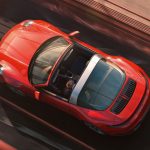The 2021MY Porsche 911 Targa 4S (manual) is only 5kg heavier than the 992 Cabriolet but carries 60kg more than its 991.2 avatar
In the world of sportscars, the Porsche 911 occupies a special place despite creeping into supercar territory lately. The 911 portfolio is broad and oftentimes confusing but Porsche fans find a hidden pleasure in pinpointing each and every model by combining random digits and letters. With a strong heritage of over 50 years, the Porsche 911 is currently in its 8th ‘evolution’.
So far, the German marque has unveiled the 992 in Carrera, Cabriolet and Turbo formats while the much-awaited GT series is busy at the ring attaining dynamic perfection. With a minor leap from the previous 991.2, Porsche has taken a near-perfect product and ironed out some key essentials. In the process, the 992 series got a bit fatter and blander without being a deal-breaker.
Amid the ongoing COVID confusion, Porsche has introduced the 992 Targa in S and 4S formats. Like the new-gen Carrera and Cabriolet, the Targa does not stand wide apart from its predecessor. It continues to offer the familiar “open-top driving in a cabriolet paired with the sleek convenience of a coupe”. As pointless as it seems, the new Targa is still a 2+2 sportscar.
Porsche’s Targa range may not be everyone’s cup of tea but has always been an absolute desire for almost all 911 enthusiasts. This could also be the reason why the legends at Singer Vehicle Design offer their art in Targa formats as well. Driving a 911 Targa model — be it any generation — imparts a sense of occasion which, in most cases, transforms the car into a wholesome experience than a well-engineered machine.
However, one could argue that the 991.2 Targa looked better than the 992 in their respective base forms. Criticism starts from the rear proportions. The Type 992’s LED taillight bar makes an illusion that the existing rear bulkiness of a modern-day Porsche convertible (to house the roof mechanism) is even more pronounced. This further forms an odd haunch on the rear quarters. To a good extent, this abnormality depends on the viewing angle (which is now limited to media release images). Yet, it would take some time to grow.

Viewed from the front quarter, the 992 Porsche 911 Targa remains a charmer, especially in a dark shade. In typical premium-car fashion, visuals greatly depend on the taste in ticking the right cosmetic options.
Both the Targa 4 and 4S models are powered by the improved 3.0-litre twin-turbo flat-6 in the exact tune as its Carrera/Cabriolet siblings. Output figures are rated at 380bhp/450Nm and 444bhp/530Nm for the 4 and 4S variants, respectively. While an 8-speed PDK is available as standard to power all four wheels (as the ‘4’ implies), the higher Targa 4S is also offered with a no-cost 7-speed manual option alongside Sports Chrono.
The Targa 4 can do a 0-100km/h sprint in around 4 seconds before topping out at 288km/h. For the Targa 4S, the figures stand at roughly 3.6 seconds and 303km/h. These numbers apply in closed-roof configuration and in usual Porsche fashion, could be undercounted as well.
The 2021MY Porsche 911 Targa would probably remain the heaviest 992 model. To give a rough idea, the 992 Targa 4S (manual) is 60kg heavier than the 991.2 version or 5kg more than the 992 4S Cabriolet. It takes both Targa variants 19 seconds to switch between open- and closed-roof configurations (7 seconds slower than the 992 Cabriolet).
On the other hand, a good majority are waiting for the 992 Targa GTS. The Porsche 911’s GTS line strikes an effective balance between the sportscar-ish Carrera and supercar-ish GT.






